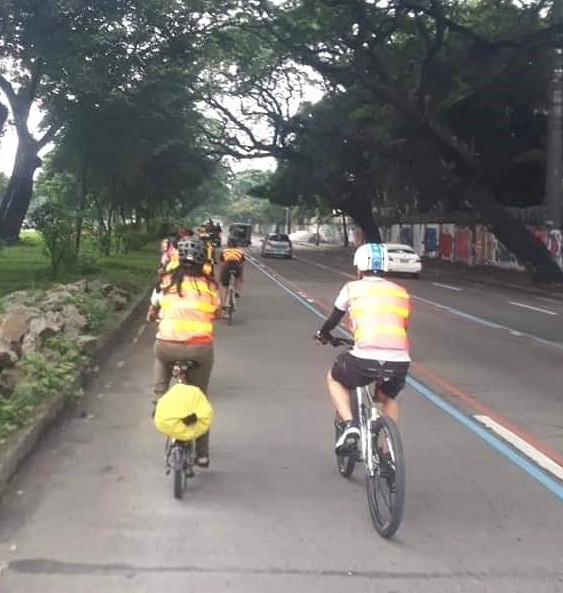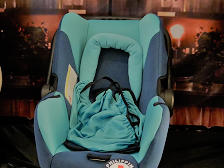
In rush-hour traffic, Mia Bunao can get to Makati City from her home in Quezon City, a 16-kilometer journey, in one hour and 20 minutes.
And she can do this day after day without standing in a long queue that snakes down a side street while waiting for public transport, and then later enduring a two-to-three-hour trip in a jam-packed bus crawling along Metro Manila’s gridlocked roads, or taking a shorter ride on a train that could suffer a breakdown any time.
Her choice does not require a single drop of gasoline or diesel.
For nearly two decades, Bunao has been using a vehicle that has been around for some 200 years and which nearly everyone knows about: a bicycle.
“In 2001, I was working at ABS-CBN and I lived on Kamias Road,” the volunteer for road safety and mobility group Kalyetista told VERA Files.
“If I drove a car or took public transportation, it would take me 30 to 45 minutes to cross EDSA because of traffic,” she said. “If I walked, it was about 25 minutes. If I biked, it was just 12 minutes. That was my incentive: everything seemed faster.”
Not just an ‘alternative’
Vehicles like bicycles and kick scooters have gained popularity in Europe and China amid worsening urban road congestion.
But getting around the country’s urban centers other than riding a car still faces an uphill battle, although motorized two-wheelers are becoming a popular option as well.
Bunao believes the first step to changing the car culture and, thus, addressing road congestion is for people to rethink what a “normal” commute is.

There is need to change the car culture, says Mia Bunao.
“Things like protected bike lanes give a sense of space and a sense of legitimacy,” she said. “It makes you feel like you’re actually being planned for, that you’re not just ‘alternative’ transport. You’re part of the transportation system,” she said at a round table discussion on pedestrian and commuter safety at the University of the Philippines (UP) in Diliman on Dec 3.
According to the Chamber of Automotive Manufacturers of the Philippines, Inc., which represents the largest car makers in the country, sales of passenger and commercial vehicles from January to October 2019 went up 2.5 per cent to 301,761 units from the same period last year, indicating the continuing demand for cars and other commercial vehicles.

Atty Yla Paras says safe system approach is important
“Especially in the Philippines, there is a car culture, so vehicles on the road are given more importance than pedestrians, but it should be the other way around because there are really more pedestrians,” said Atty Yla Paras, a fellow of the Bloomberg Initiative for Global Road Safety Legal Development Program (BIGRS-LDP), at the same forum supported by the World Health Organization (WHO).
She there is a lack of laws to protect cyclists and pedestrians so it is important to observe the safe system approach which caters to the different components of the road system: the users, the vehicles and the infrastructure.
Under the Department of Transportation’s Philippine Road Safety Action Plan, the government should (1) “integrate road safety features in the design of roads to protect vulnerable road users,” and (2) “provide safe, affordable, accessible, and sustainable infrastructure for non-motorized transport systems.”
‘Build it and they will come’
Indeed, rethinking how and for whom the Philippines designs its roads is a major step in reducing congestion.
In China and European countries, the government puts up facilities like dedicated bike lanes, bike parking areas and even showers to encourage people to pedal to where they need to go.

Bicycle lanes will encourage people to bike, says Ira Cruz
Ira Cruz, director of commuter advocacy group AltMobility, said at the UP forum that the Philippine government must provide facilities for the most vulnerable road users, who include children, cyclists and persons with disability.
“Infrastructure dictates behavior,” he said. “If you make your roads wider, more and more cars will use these. The same goes for bicycle lanes and sidewalks: build it and people will come. People will be encouraged to bike,” he added.
Citing the National Association for City Transport Officials, a group of North American cities and transit agencies, Cruz said the ideal sidewalk should be wide enough to accommodate the frontage of establishments, walkways for pedestrians, seating areas and lamp posts, as well as separate bike lanes.

NACTO recommends that sidewalks should have dedicated spaces for pedestrians, seating areas and cyclists. Photo courtesy of NACTO website.
“What happens in the Philippines is that everybody and everything shares the same very small space, which goes to show who we really are prioritizing in road design,” he said.
Kalyetista’s Bunao, meanwhile, said Marikina’s vast bike lane network is one of the steps in the right direction.
“It’s more than 66 kilometers and these are on main roads and internal roads, meaning they’re on side streets, as well as alleyways that larger vehicles can’t use,” she said in an interview.
“You really have a sense of interconnectedness because you can go to the palengke (market), to your school and actually find safer routes, which is ideal if you’re just starting out or if you’re encouraging people to start biking,” Bunao added.
Poverty-inducing injuries and deaths
Indeed, better infrastructure isn’t just about making travel smoother. It’s about ensuring safety on the road.
In its 2018 Global Status Report on Road Safety, the WHO found that road crashes are the eighth leading cause of death globally and are now considered the top killer of young people aged 5 to 29 years old.
From the 1.35 million road-crash deaths recorded worldwide in 2016, around one in four were pedestrians and cyclists.
Citing data from the Metropolitan Manila Development Authority, Bunao also noted at the forum that 1,127 cyclists were killed from 2005 to 2013.
Eric Lazarte, WHO Philippines technical officer, said the lack of pedestrian facilities, especially outside the cities, makes pedestrians more exposed to risks. Most collisions here take place in pedestrian crossings while others are hit by vehicles while they are walking or standing along the roads, he said.

Many pedestrians hit by vehicles are disabled.
“Worldwide, a high percentage of pedestrian deaths takes place at night or early morning when it is still dark, especially in the rural areas without street lights,” he said during the forum at UP.
In the Philippines, Lazarte added, these collisions result in disabilities, traumatic brain injury, spinal injuries. “According to rescuers we’ve talked with, most pedestrians get hit in the lower limbs.”
And apart from the huge costs that patients must pay for hospitalization and rehabilitation, which often put them into serious poverty, road crashes in the Philippines cost one to three percent of the country’s gross domestic product (GDP), he said.
GDP is the value of goods and services produced in a country in a year. It is considered the barometer of a nation’s economic health.
“When there are more people who are hospitalized, more is charged to Philhealth (national health insurance system) and more people lose their jobs,” Lazarte said.
Better for nature and one’s wallet
If Bunao’s bike commute is astonishing, wait till you hear about how little time it takes Ira Cruz to get to Makati City from his home in Pasig City.
At 4 p.m., which is when the rush hour madness starts to ravage the metro’s streets, Cruz can complete the 6-kilometer trip in just 15 minutes using nothing but an electric kick scooter.
“It is faster and (entails) less effort,” he said. “And since an electric kick scooter is foldable, I can bring it inside a coffee shop, a point-to-point (P2P) bus or the train.”
Cruz said his electric kick scooter has led to big savings since he started using it in October last year. “I was able to recover the cost of my kick scooter within one month,” he said. “That’s taking into consideration how much I used to spend on Grab or for other modes of public transport. It’s really quite an investment.”
Leaving one’s car at home is a more sustainable and environmentally friendly way of getting around, he explained.
Indeed, Bunao said part of the reason she hasn’t stopped cycling, even though Metro Manila traffic congestion has significantly worsened, is her environmental advocacy.
“It was a natural transition because from the clean air campaign to phasing out leaded gasoline to preserving forests, so everything just came together,” she said.
“Once you’ve been doing it a long time, you get used to it and it’s part of your lifestyle.”

Find friends to bike with. There is safety in numbers. Photo courtesy of Kalyetista.
Taking the plunge
If people want to leave behind waiting in line and sitting in traffic for hours, here are some things that Cruz and Bunao suggest:
1. Plan your route.
Finding out where one regularly goes will determine what kind of vehicle/s he or she would use, whether it is a kick scooter, a bicycle or a combination of transport services.
“I wrote down my usual commute destinations and I decided that my preferred transport route is bimodal because I like buses, I like trains,” Cruz said.
“Find a bike that fits you,” said Bunao. “A lot of the bike shops can advise you what kind of bike you can get.”
2. Be ready to be yelled at.
Commuting by bike or scooter in “car-centric” Metro Manila means sharing the road with people who don’t really believe in sharing.
“If there is no bike lane, then there is no defined place for you to ride,” Cruz said. “If you’re a newbie, you would be biking on the gutter so cars normally edge you out.”
“You get honked at, I’ve been yelled at by jeepney drivers telling me to get out of the way, I’ve disappeared in exhaust smoke,” he added. “Those are the hazards.”
Meanwhile, Bunao said one should start somewhere comfortable before thinking of doing longer journeys more regularly.
“You don’t have to do it every day,” she said. “You can just commit yourself to once a week and then you build your resistance over time.”
3. Find friends.
There is a thriving online community of bicyclists who would be glad to “bikepool”.
“It’s true when they say there’s safety in numbers,” Altmobility’s Cruz said. “Either you bring along friends who are interested in biking to work or to school or get someone who’s experienced to ride with you.”
This story was produced under the Road Safety Journalism Fellowship of VERA Files, with support of the World Health Organization, under the Bloomberg Initiative for Global Road Safety.





